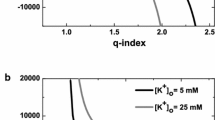Abstract
Non-stationary fluctuation analysis was applied to macroscopic records of junctional currents arising from homotypic Cx37 and Cx43 gap junction channels expressed in RIN cells. The data were analyzed by a modification of existing analytical methods that takes endemic uncoupling into account. The results are consistent with both channels having open probabilities ranging from 0.7 to near unity for low transjunctional voltages. The analysis also yielded estimates of single-channel conductances for the two channel types similar to those seen in single-channel recordings. The results presented here show that fluctuation analysis can be used to extract single-channel gap junctional conductances from macroscopic double whole-cell recordings. These results also constitute empirically determined estimates of the open probability that are not model-dependent.



Similar content being viewed by others
References
Beyer E.C. Gap junctions. 1993. Intl. Rev. Cyto. 137C:1–37
Brink P.R., Ramanan S.V., Christ G.J. 1996. Human connexin43 gap junction channel gating: evidence for mode shifts and/or heterogeneity. Amer. J. Physiol. 271:C321–C331
Brink P.R., Valiunas V., Ramanan S.V. 1999. High open probability demonstrated through non-stationary noise analysis in three gap junctions. International gap junction conference. Bern, Switzerland
Bukauskas F., Bukauskiene A.A., Verselis V.K., Bennett M.V.L. 2002. Coupling asymmetry of heterotypic connexin45/connexin43-EGFP gap junction: Properties of fast and slow gating mechanisms. Proc. Nat. Acad. Sci. USA 99:7113–7118
Bukauskas F., Elfgang C., Willecke K., Weingart R. 1995. Biophysical properties of gap junction channels formed by mouse connexin40 in induced pairs of transfected HeLa cells. Biophys. J. 68:2289–2298
Burt J.M., Spray D.C. 1988. Inotropic agents modulate gap junctional conductance between cardiac myocytes. Amer. J. Physiol. 254:H1206–H1210
Chen-Izu Y., Moreno A.P., Spangler S.R.A. 2001. Opposing gates model for voltage gating of gap junction channels. Amer. J. Physiol. 281:C1604–C1613
Dun W., Jiang M., Tseng G.N. 1999. Allosteric effects of mutations in the extracellular S5-P loop on the gating and permeation properties of the hERG potassium channel. Pfluegers Arch. 439:141–149
Harris A.L. 2001. Emerging issues of connexin channels: biophysics fills the gap. Quart. Rev. Biophys. 34:325–472
He D.S., Jiang J.X., Taffet S.M., Burt J.M. 1999. Formation of heteromeric gap junction channels by connexins 40 and 43 in vascular smooth muscle cells. Proc. Natl. Acad. Sci. 96:6495–6500
Hille B. 1992. Ionic channels of excitable membranes. 2nd ed. Sinauer Associates, Inc. Sunderland, Ma
Lu T., Ting A.Y.M., Mainland J., Jan L.Y., Schultz P.O., Yang Y. 2001. Probing ion permeation and gating in a K+ channel with backbone mutations in the selectivity filter. Nat. Neurosci. 4:239–246
Moreno A.P., Rook M.R., Fishman G.I., Spray D.C. 1994. Gap junction channels; distinct voltage sensitive and insensitive conductance states. Biophys J. 67:113–119
Musa H., Veenstra R.D. 2003. Voltage-dependent blockade of connexin40 gap junctions by spermine. Biophys. J. 84:205–219
Neyton J., Trautmann A. 1985. Single channel currents of an intercellular junction. Nature. 317:331–335
Noceti F., Baldelli P., Wei X., Qin N., Toro L., Birnbaumer L., Stefani E. 1996. Effective gating charges per channel in voltage-dependent K+ and Ca2+ channels. J. Gen. Physiol. 108:143–155
Ramanan S.V., Brink P.R., Varadaraj K., Peterson E., Schirrmacher K., Banach K. 1999. A three-state model for connexin37 gating kinetics. Biophys. J. 76:2520–2529
Sigworth F.J. 1985. Open channel noise. I. Noise in acetylcholine receptor currents suggests conformational fluctuations. Biophys J. 47:709–720
Sigworth F.J. 1980. The variance of sodium currents at the node of Ranvier. J. Physiol. 307:97–129
Takens-Kwak B. R., Jongsma H.J. 1992. Cardiac gap junctions: three distinct single channel conductances and their modulation by phosphorylating treatments. Pfluegers Arch. 422:198–200
Trexler E.B., Bennett M.V.L., Bargiello T.A., Verselis V.K. 1996. Voltage gating and permeation in a gap junction hemichannel. Proc. Nat. Acad. Sci. USA 93:5836–5841
Valiunas V., Beyer E.C., Brink P.R. 2002. Cardiac gap junction channels show quantitative differences in selectivity. Circ. Res. 91:104–111
Valiunas V., Bukauskas F., Weingart R. 1997. Conductances and selective permeability of connexin43 gap junction channels examined in Neonatal rat heart cells. Circ. Res. 80:708–719
Valiunas V., Weingart R., Brink P.R. 2000. Formation of heterotypic gap junction channels by connexins Cx40 and Cx43. Circ. Res. 86:e42–e49
Valiunas V., Weingart R. 2001. Co-operativity between mouse connexin30 gap junction channels. Pfluegers Arch. 441:756–60
Veenstra R.D., Wang Z., Beyer E.G., Ramanan S.V., Brink P.R. 1994. Connexin37 forms high conductance gap junction channels with subconductance state activity and selective dye and ionic permeabilities. Biophys. J. 66:1915–1928
Veenstra R.D. 2001. Voltage clamp limitations of dual whole-cell gap junction current and voltage recordings. I. Conductance measurements. Biophys. J. 80:2231–2247
White T., Bruzzone R. 1996. Multiple connexin proteins in single intercellular channels: connexin compatability and functional consequences J. BioEner. Biomembranes. 28:339–350
Wilders R., Jongsma H. 1992. Limitation of the dual voltage clamp method in assaying conductance and kinetics of gap junction channels. Biophys. J. 63:942–953
Willecke K., Eiberger J., Degan J., Eckardt D., Romualdi A., Guldenagel M., Deutsch U., Sohl G. 2002. Structural and functional diversity of connexin genes in the mouse and human genome. Biol. Chem. 383:725–737
Acknowledgement
We thank the reviewers for their comments. This work was, in part, funded by Wellcome Trust grant 070069 (SVR) and NIH grant 55263 (PRB).
Author information
Authors and Affiliations
Corresponding author
Rights and permissions
About this article
Cite this article
Ramanan, S., Valiunas, V. & Brink, P. Non-Stationary Fluctuation Analysis of Macroscopic Gap Junction Channel Records. J Membrane Biol 205, 81–88 (2005). https://doi.org/10.1007/s00232-005-0765-4
Received:
Revised:
Issue Date:
DOI: https://doi.org/10.1007/s00232-005-0765-4




